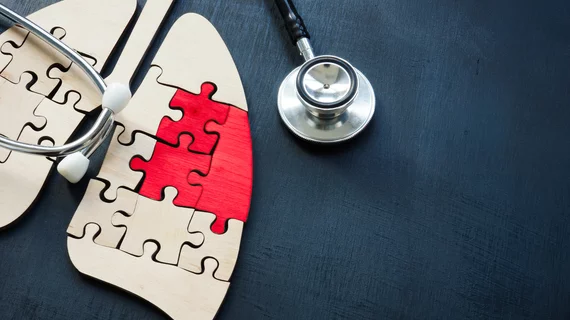Unnecessary follow-up tests may be dissuading individuals from returning for future cancer screenings
An inordinate number of patients are receiving unnecessary follow-up imaging and other procedures after lung cancer screening despite not having the disease, according to a new analysis.
Numerous studies have documented Americans’ minuscule uptake of low-dose CT to screen for the disease, with one estimating only 3% of eligible individuals are imaged. But few analyses have explored the impact of downstream, follow-up procedures on patients’ willingness to return for future screening intervals.
Researchers recently examined this phenomenon, sharing their work Aug. 14 in the Journal of the American College of Radiology [1]. Across more than 30,000 negative lung cancer screening exams delivered over a six-year period, 17.7% led to additional testing. Chest computed tomography within four months was the most common follow-up, occurring after 9.1% of LCS exams.
Downstream diagnostic imaging tests or invasive procedures were associated with a decreased likelihood of repeat annual lung cancer screening (adjusted odds ratio, 95%), after controlling for various patient characteristics.
“In light of this information, efforts are necessary to reduce the burden of false positive LCS examinations, so as to reduce the burden of such downstream testing,” lead author Tina D. Tailor, MD, of Duke University Medical Center and colleagues concluded. “Further, efforts to reduce costs associated with such procedures would likely also be helpful in ensuring that individuals who require downstream testing after LCS continue to obtain guideline-directed yearly screening.”
The study derived information from Optum’s deidentified Clinformatics Data Mart Database, representing a national sample of individuals insured via their employers, and spanning 2015 through 2020. Tailor et al. pinpointed individuals ages 55 to 80 who received a LDCT exam, excluding those who doctors diagnosed with the disease.
Altogether, 23,640 individuals received 30,521 lung cancer screening exams during the study period. Chest CT within 5-7 months was the second most common downstream test (5.6%), followed by invasive procedures such as bronchoscopy, needle biopsy or thoracic surgery (5%). Another 2.2% of LCS exams resulted in PET or PET/CT within 12 months.
Among patients referred for follow-up testing, about 34.2% incurred an out-of-pocket charge, ranging anywhere from $0 to $7,912. For those who had an OOPC charge greater than zero, the median amount was nearly $316, but the overall median dropped to $108 when including $0 in the range.
“Costs associated with downstream procedures are likely at least one reason why LCS adherence is lower in individuals necessitating such testing,” the authors wrote. “Prior work shows that [out-of-pocket costs] are associated with decreased utilization of evidence-based healthcare. As such, future policy efforts should consider mechanisms to alleviate costs related to the whole screening encounter, not just the initial screening test. While screening begins with an initial LDCT, further downstream testing is fundamental to the screening pathway.”
Read more, including potential study limitations, in JACR at the link below.

